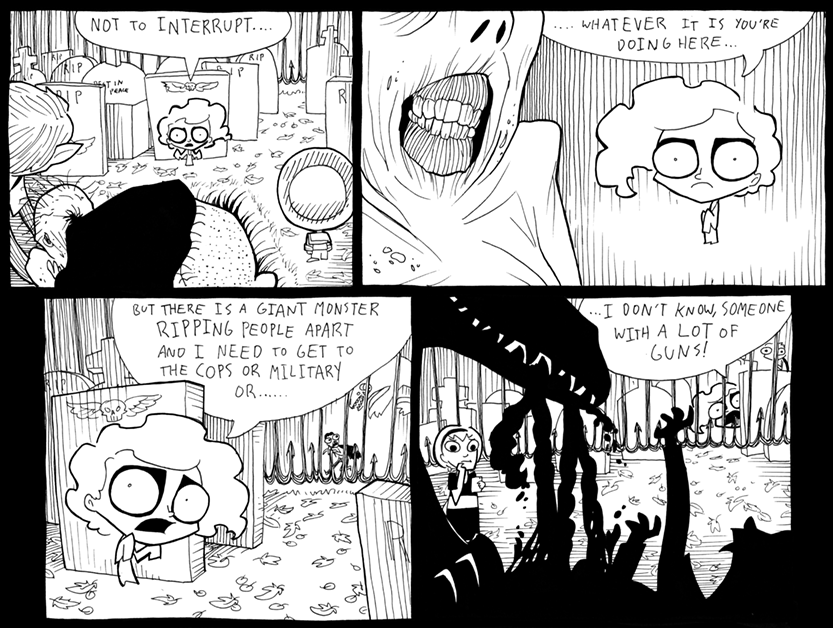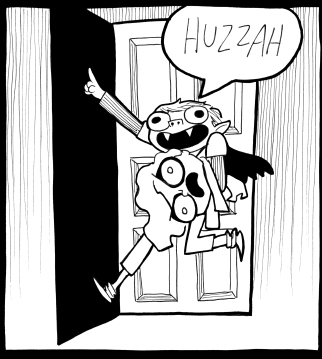When the webcomic reality show Strip Search ran last year, Abby Howard emerged as one of my favorites. As the youngest of the group, she had the least experience out of any of the contestants (eventual winner Katie Rice, for example, had worked for years in animation.) She was quite the character, though: When asked if she would consider taxidermy, Howard admitted she'd been interested in the subject for a while. She had some good jabs at Mike Krahulik and Jerry Holkins' expense in the final episode, regarding how they were trying to paint her as a villain in line with reality-show tropes. It was my favorite moment in the series.
In the finals, Howard drew with a more traditional style than her competitors. The Last Halloween was rendered in heavy black and white, with macabre style reminiscent of Edward Gorey and Jhonen Vasquez. Krahulik and Holkins remarked on the designs of her creatures and her great grasp of anatomy -- honed, perhaps, by her experience illustrating college textbooks.
While she didn't win, Howard conducted a very successful Kickstarter that met its goal in 20 minutes and raised $126,000 toward publishing a 110-page collection. The pitch is a great peek into her sense of humor: "Despite it being the cause of my humiliating defeat, I am in love with my project. It is my child. It was going to grow up and blossom into a glorious and rich story if not for the fact that I LOST STRIP SEARCH (smashes flower pot against wall in fit of passion)."
Looking back, it's a great example on how the show really did benefit webcomic creators ... and not only the winners. Would it have been possible for a previously unknown artist like Howard to raise even $500 without Penny Arcade, its expos, and its wide online reach? There was even a link on the heavily trafficked Penny Arcade site.
Fortunate, too, as The Last Halloween is delightful. Mona Merkins is a squat kid with black mascara around her eyes. It's Halloween, and she just wants to go trick-or-treating. Unfortunately, her dad (who dresses like her dead mom) is feeling really flighty today and blows her off for a party. What Mona doesn't know is that ghosts are straight-up murdering people this Halloween. Howard gets to unleash the creativity from her trademark talents: she gets to draw some twisted beasties and write cheeky dialogue. In one scene, two officers dismiss the mountains of calls they're getting of murderous creatures. Later, we see them getting skewered by the same monsters, loudly and obviously bemoaning their hubris. It got a pretty loud chuckle out of me.
So what's happening? In a strip titled "Exposition.png" (heh), we learn that each monster comes from a parallel dimension. However, each is tied to a human throughout its entire lifespan; when the humans die, they die. The only exception is if the monster kills the human, setting them free. They're prevented from doing so by the Phagocyte, which keeps the balance between parallel worlds. The phagocyte has died, though, and that means it's open season on the humans.
Escaping a many-legged spook, Mona runs into a grave-robbing group that she mistakes as costumed kids: a way-too-friendly vampire, a wererat, a Frankenstein monster obsessed with social networking, and a Haitian voodoo doll dressed as a sailor. They are, of course, the real deal ... but they used to be humans, and they're working against the monster uprising. Mona is thrust into the role of Chosen One ... something that she very reasonably declines (she's just a kid and all) but is ultimately given no choice in the matter.
The humor feels off the cuff, as if Howard just had an amusing notion that very second and couldn't wait to put pen to paper (or lightpen to Wacom tablet, or whatever). Like, maybe she thought it would be funny to have Mona scream on a page stacked 18 panels high while her new acquaintances bounce useless ideas off each other. Dragging things out is not always the best way to write a story, but it works for Howard and her kooky sense of humor.


